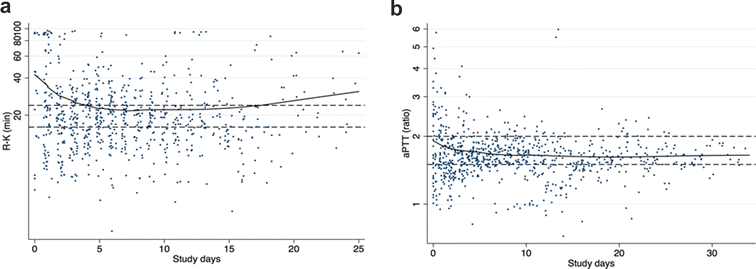Thromboelastography-based anticoagulation management during extracorporeal membrane oxygenation: a safety and feasibility pilot study
- PMID: 29340875
- PMCID: PMC5770349
- DOI: 10.1186/s13613-017-0352-8
Thromboelastography-based anticoagulation management during extracorporeal membrane oxygenation: a safety and feasibility pilot study
Abstract
Background: There is no consensus on the management of anticoagulation during extracorporeal membrane oxygenation (ECMO). ECMO is currently burdened by a high rate of hemostatic complications, possibly associated with inadequate monitoring of heparin anticoagulation. This study aims to assess the safety and feasibility of an anticoagulation protocol for patients undergoing ECMO based on thromboelastography (TEG) as opposed to an activated partial thromboplastin time (aPTT)-based protocol.
Methods: We performed a multicenter, randomized, controlled trial in two academic tertiary care centers. Adult patients with acute respiratory failure treated with veno-venous ECMO were randomized to manage heparin anticoagulation using a TEG-based protocol (target 16-24 min of the R parameter, TEG group) or a standard of care aPTT-based protocol (target 1.5-2 of aPTT ratio, aPTT group). Primary outcomes were safety and feasibility of the study protocol.
Results: Forty-two patients were enrolled: 21 were randomized to the TEG group and 21 to the aPTT group. Duration of ECMO was similar in the two groups (9 (7-16) days in the TEG group and 11 (4-17) days in the aPTT group, p = 0.74). Heparin dosing was lower in the TEG group compared to the aPTT group (11.7 (9.5-15.3) IU/kg/h vs. 15.7 (10.9-21.3) IU/kg/h, respectively, p = 0.03). Safety parameters, assessed as number of hemorrhagic or thrombotic events and transfusions given, were not different between the two study groups. As for the feasibility, the TEG-based protocol triggered heparin infusion rate adjustments more frequently (p < 0.01) and results were less frequently in the target range compared to the aPTT-based protocol (p < 0.001). Number of prescribed TEG or aPTT controls (according to study groups) and protocol violations were not different between the study groups.
Conclusions: TEG seems to be safely used to guide anticoagulation management during ECMO. Its use was associated with the administration of lower heparin doses compared to a standard of care aPTT-based protocol. Trial registration ClinicalTrials.gov, October 22,2014. Identifier: NCT02271126.
Keywords: Anticoagulation; Extracorporeal membrane oxygenation; Hemorrhage; Heparin; Thromboelastography; Thrombosis.
Figures



References
-
- Panigada M, Artoni A, Passamonti SM, et al. Hemostasis changes during veno-venous extracorporeal membrane oxygenation for respiratory support in adults. Minerva Anestesiol. 2016;82:170–179. - PubMed
Associated data
LinkOut - more resources
Full Text Sources
Other Literature Sources
Medical
Research Materials

